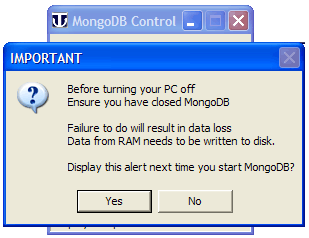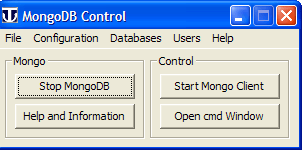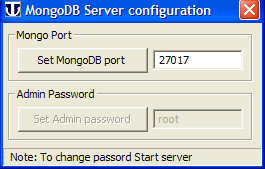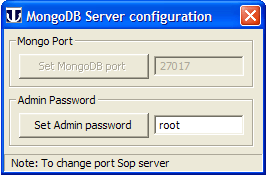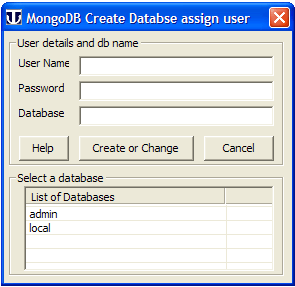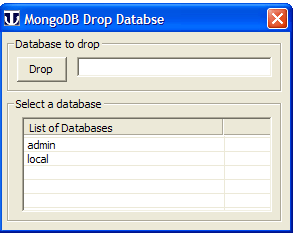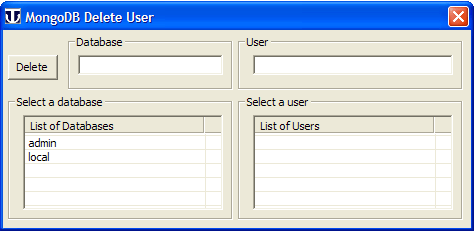MongoDB: Production Standalone: Difference between revisions
(New page: {{Nav MongoDB}} '''''MongoDB''''' == Introduction == MongoDB Standalone Production installs MongoDB server. A Windows interface is provided allowing you to start and stop MongoDB server....) |
(Punctuation and grammatical changes; some clarification.) |
||
| Line 4: | Line 4: | ||
MongoDB Standalone Production installs MongoDB server. | MongoDB Standalone Production installs MongoDB server. | ||
A Windows interface is provided allowing you to start and stop MongoDB server. From this interface you can start either the mongo-client or a cmd prompt. These allow you to administer mongo-databases. | A Windows interface is provided, allowing you to start and stop MongoDB server. From this interface you can start either the mongo-client or a cmd prompt. These allow you to administer mongo-databases. | ||
From the drop-down menus you can create and delete databases | From the drop-down menus you can create and delete databases. In addition, you can assign and delete users for a database. | ||
Production in this context is referring to authenticated access. All databases are assigned a user name and user password. | Production in this context is referring to authenticated access. All databases are assigned a user name and user password. When creating a database, you are required to provide a name and password. | ||
The Admin database is pre-configured with a name and password of root and root respectively. | The Admin database is pre-configured with a name and password of '''root''' and '''root''' respectively. | ||
The first task after installation is to change this Admin default password. | |||
Independent operation is achieved using a single binary (PHP 5.3.2 compiled with common extensions including new WinBinder with UTF-8 support) extracted from phpack v0.7.5 see [http://winbinder.org/forum/viewtopic.php?f=8&t=1148 '''Winbinder forum'''] for details. The dll is located in phpack basic stubs folder. | Independent operation is achieved using a single binary (PHP 5.3.2 compiled with common extensions including new WinBinder with UTF-8 support) extracted from phpack v0.7.5 see [http://winbinder.org/forum/viewtopic.php?f=8&t=1148 '''Winbinder forum'''] for details. The dll is located in phpack basic stubs folder. | ||
== Download and Install == | == Download and Install == | ||
=== Options 1 === | === Options 1 === | ||
* Download file mongo_pro_standalone_v1_0.exe from Sourceforge | * Download file '''''mongo_pro_standalone_v1_0.exe''''' from Sourceforge | ||
* Save to any folder (no spaces in path) | * Save to any folder (no spaces in path) | ||
* To extract files, double click on file mongo_pro_standalone_v1_0.exe no need to change the path. | * To extract files, double click on file mongo_pro_standalone_v1_0.exe no need to change the path. | ||
| Line 27: | Line 25: | ||
=== Options 2 === | === Options 2 === | ||
* Download file mongo_pro_standalone_v1_0.zip from Sourceforge | * Download file '''''mongo_pro_standalone_v1_0.zip''''' from Sourceforge | ||
* Save to any folder (no spaces in path) | * Save to any folder (no spaces in path) | ||
* Extract files, navigate to folder mongo_pro_standalone_v1_0 | * Extract files, navigate to folder mongo_pro_standalone_v1_0 | ||
| Line 35: | Line 33: | ||
For download details see [[MongoDB: Introduction | '''MongoDB Introduction (Main Start page)''']] | For download details see [[MongoDB: Introduction | '''MongoDB Introduction (Main Start page)''']] | ||
== Run == | == Run == | ||
| Line 45: | Line 42: | ||
Double click on file '''Run_MongoDB.exe''' located in folder mongodb_1. | Double click on file '''Run_MongoDB.exe''' located in folder mongodb_1. | ||
* I hate nag pop-ups | * I hate nag pop-ups, but this one is very important. | ||
* Always close MongoDB before turning your PC off | * '''Always''' close MongoDB before turning your PC off. | ||
* It needs to perform a clean up to maintain data integrity. | * It needs to perform a clean up to maintain data integrity. | ||
The nag pop-up can be infuriating | The nag pop-up can be infuriating, but you can click '''''no''''' to not display it again at next start up. | ||
'''''Note'':''' If you want to restore the nag pop-up delete the following file: | '''''Note'':''' If you want to restore the nag pop-up, delete the following file: | ||
mongodb_1\control\'''no_nag.txt''' | mongodb_1\control\'''no_nag.txt''' | ||
| Line 62: | Line 59: | ||
Start server click '''Start MongoDB''' button. | Start server click '''Start MongoDB''' button. | ||
'''''Note'':''' With the server running greyed out button is enabled. | '''''Note'':''' With the server running, greyed out button is enabled. | ||
'''''Stop Server''''' | '''''Stop Server''''' | ||
| Line 79: | Line 76: | ||
'''Button ''Start Mongo Client''''' | '''Button ''Start Mongo Client''''' | ||
Opens a command window and runs mongo-client. Button is enabled when server is running otherwise | Opens a command window and runs mongo-client. Button is enabled when server is running; otherwise it's disabled. | ||
'''Button ''Help and Information''''' | '''Button ''Help and Information''''' | ||
| Line 89: | Line 86: | ||
|} | |} | ||
'''''Note 1'':''' When challenged by your firewall always grant Internet access | '''''Note 1'':''' When challenged by your firewall, always grant Internet access. | ||
'''''Note 2'':''' This server runs as a standard program and not as a service. | '''''Note 2'':''' This server runs as a standard program and not as a service. | ||
== Menu Bar == | == Menu Bar == | ||
| Line 101: | Line 96: | ||
* '''''Configuration''''' | * '''''Configuration''''' | ||
# ''Change Port'' - Change Mongo listen port | # ''Change Port'' - Change Mongo listen port | ||
# ''Change Admin Password'' - Change default Admin | # ''Change Admin Password'' - Change default Admin password | ||
* '''''Databases''''' | * '''''Databases''''' | ||
# ''Create Database'' - Create a new database assign user and password<br>For an existing database update user password<br>For existing database assign a new user and password | # ''Create Database'' - Create a new database, assign user and password<br>For an existing database update user password<br>For existing database assign a new user and password | ||
# ''Drop Database'' - Select a | # ''Drop Database'' - Select a database and delete it - | ||
* '''''Users''''' | * '''''Users''''' | ||
# Add User - | # Add User - Add new user and password to existing database | ||
# Delete User - Select database lists all users select a user and delete | # Delete User - Select database lists all users select a user and delete | ||
| Line 114: | Line 109: | ||
# ''Help'' - Displays help file | # ''Help'' - Displays help file | ||
# ''About'' - Displays Components details and version | # ''About'' - Displays Components details and version | ||
=== Configuration === | === Configuration === | ||
Both menu items open the same pop-up window | Both menu items open the same pop-up window | ||
| Line 123: | Line 118: | ||
* Enabled only when MongoDB server stopped | * Enabled only when MongoDB server stopped | ||
* | * Enter new listening port | ||
* Click button Set MongoDB Port | * Click button Set MongoDB Port | ||
* Close window (cross top right) | * Close window (cross top right) | ||
| Line 141: | Line 136: | ||
[[Image:Mongodb_common_2.gif]] | [[Image:Mongodb_common_2.gif]] | ||
|} | |} | ||
=== Databases === | === Databases === | ||
These menu items require MongoDB to be running | These menu items require MongoDB to be running | ||
| Line 156: | Line 151: | ||
'''''Note'':''' | '''''Note'':''' | ||
This pop-up is | This pop-up is multi-purpose | ||
| | | | ||
[[Image:Mongodb_create_db.gif]] | [[Image:Mongodb_create_db.gif]] | ||
| Line 170: | Line 165: | ||
[[Image:Mongodb_drop_db.gif]] | [[Image:Mongodb_drop_db.gif]] | ||
|} | |} | ||
=== Users === | === Users === | ||
| Line 205: | Line 199: | ||
[[Image:Mongodb_delete_user.gif]] | [[Image:Mongodb_delete_user.gif]] | ||
|} | |} | ||
== Alternative control == | == Alternative control == | ||
| Line 218: | Line 212: | ||
you to run MongoDB's command line tools | you to run MongoDB's command line tools | ||
</pre> | </pre> | ||
== Summary == | == Summary == | ||
Running MongoDB is | Running MongoDB is really simple. | ||
Hey! If you don’t like the control interface, change it; [[MongoDB Tutorial 3: Introduction | MongoDB Tutorial 3]] provides details. | |||
---- | ---- | ||
Revision as of 00:35, 6 September 2010
|
MongoDB : Introduction | Standalone | Plugin | Production Standalone | Production Plugin
|
|
| UniServer 6-Carbo MongoDB Uniform Server Series. |
MongoDB
Introduction
MongoDB Standalone Production installs MongoDB server.
A Windows interface is provided, allowing you to start and stop MongoDB server. From this interface you can start either the mongo-client or a cmd prompt. These allow you to administer mongo-databases.
From the drop-down menus you can create and delete databases. In addition, you can assign and delete users for a database.
Production in this context is referring to authenticated access. All databases are assigned a user name and user password. When creating a database, you are required to provide a name and password.
The Admin database is pre-configured with a name and password of root and root respectively. The first task after installation is to change this Admin default password.
Independent operation is achieved using a single binary (PHP 5.3.2 compiled with common extensions including new WinBinder with UTF-8 support) extracted from phpack v0.7.5 see Winbinder forum for details. The dll is located in phpack basic stubs folder.
Download and Install
Options 1
- Download file mongo_pro_standalone_v1_0.exe from Sourceforge
- Save to any folder (no spaces in path)
- To extract files, double click on file mongo_pro_standalone_v1_0.exe no need to change the path.
- Navigate to folder mongodb_1.
- Double click Run_MongoDB.exe opens control menu
Options 2
- Download file mongo_pro_standalone_v1_0.zip from Sourceforge
- Save to any folder (no spaces in path)
- Extract files, navigate to folder mongo_pro_standalone_v1_0
- Navigate to folder mongodb_1.
- Double click Run_MongoDB.exe opens control menu
For download details see MongoDB Introduction (Main Start page)
Run
|
Start Windows interface Double click on file Run_MongoDB.exe located in folder mongodb_1.
The nag pop-up can be infuriating, but you can click no to not display it again at next start up. Note: If you want to restore the nag pop-up, delete the following file: mongodb_1\control\no_nag.txt |
|
|
Start Server Start server click Start MongoDB button. Note: With the server running, greyed out button is enabled. Stop Server Button toggles displaying Stop MongoDB Open cmd Window Opens a command window and changes to folder: mongodb_1\bin Provides access to Mongo’s suite of command-line tools. |
|
|
Button Start Mongo Client Opens a command window and runs mongo-client. Button is enabled when server is running; otherwise it's disabled. Button Help and Information Opens main read me file in Notepad. |
Note 1: When challenged by your firewall, always grant Internet access.
Note 2: This server runs as a standard program and not as a service.
Menu Bar
- File
- Exit - Close application
- Configuration
- Change Port - Change Mongo listen port
- Change Admin Password - Change default Admin password
- Databases
- Create Database - Create a new database, assign user and password
For an existing database update user password
For existing database assign a new user and password - Drop Database - Select a database and delete it -
- Users
- Add User - Add new user and password to existing database
- Delete User - Select database lists all users select a user and delete
- Help
- Help - Displays help file
- About - Displays Components details and version
Configuration
Both menu items open the same pop-up window
|
Change Port
|
|
|
Change Admin Password
|
Databases
These menu items require MongoDB to be running
|
Create Database
Note: This pop-up is multi-purpose |
|
|
Drop Database
|
Users
These menu items require MongoDB to be running
|
Add User
New User - No user or password displayed
Existing User - User name displayed Change password for that user
|
|
|
Delete User
|
Alternative control
If you prefer to use batch files take a look in folder alt_control_2
Files:
Run_start_mongo.bat - Run MongoDB server hidden
Run_stop_mongo.bat - Cleanly stop MongoDB server
Run_client.bat - Directly runs mongo-client
Run_cmd.bat - Opens a command window changes to bin folder allowing
you to run MongoDB's command line tools
Summary
Running MongoDB is really simple.
Hey! If you don’t like the control interface, change it; MongoDB Tutorial 3 provides details.
